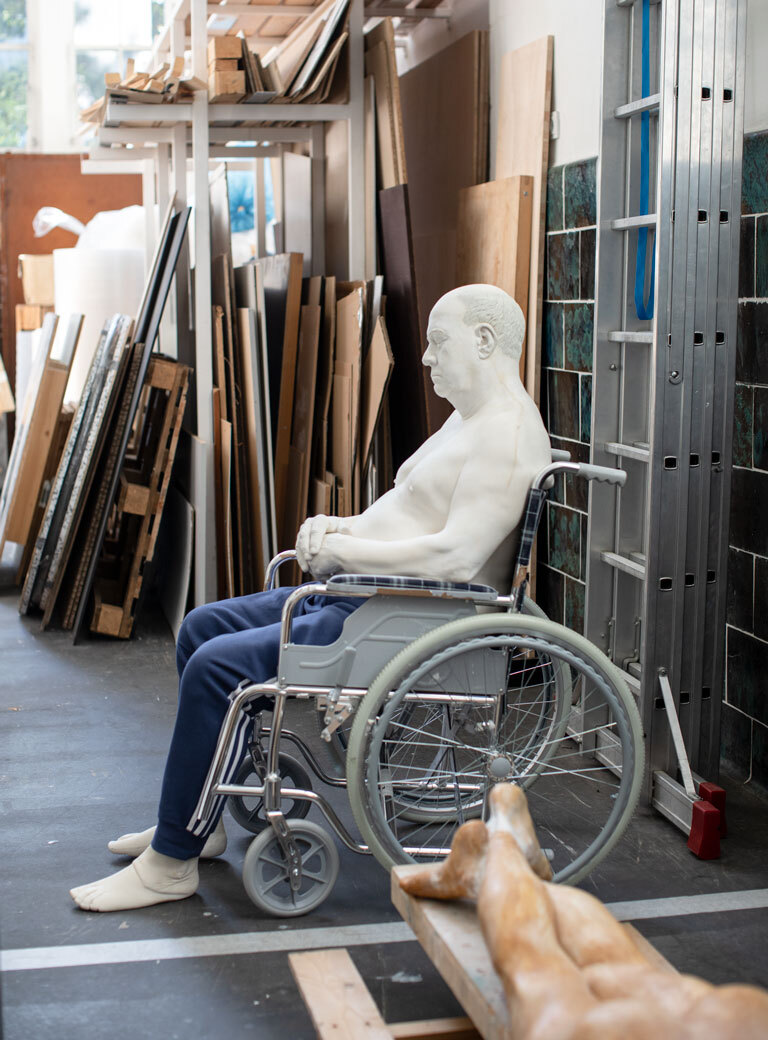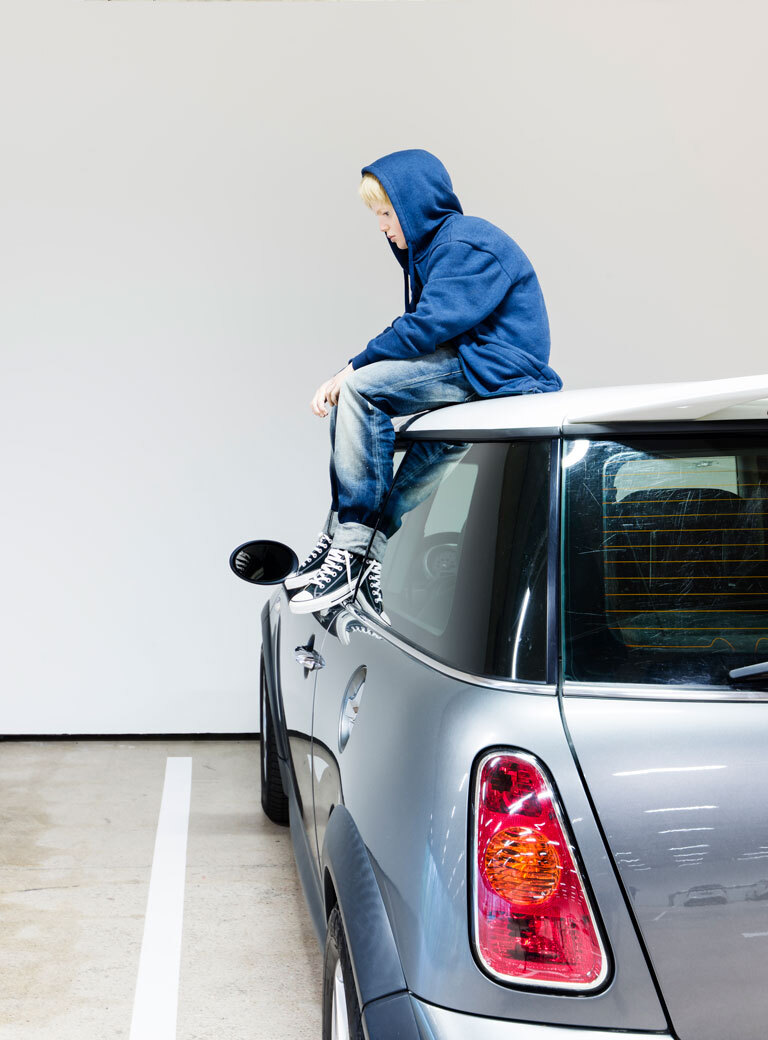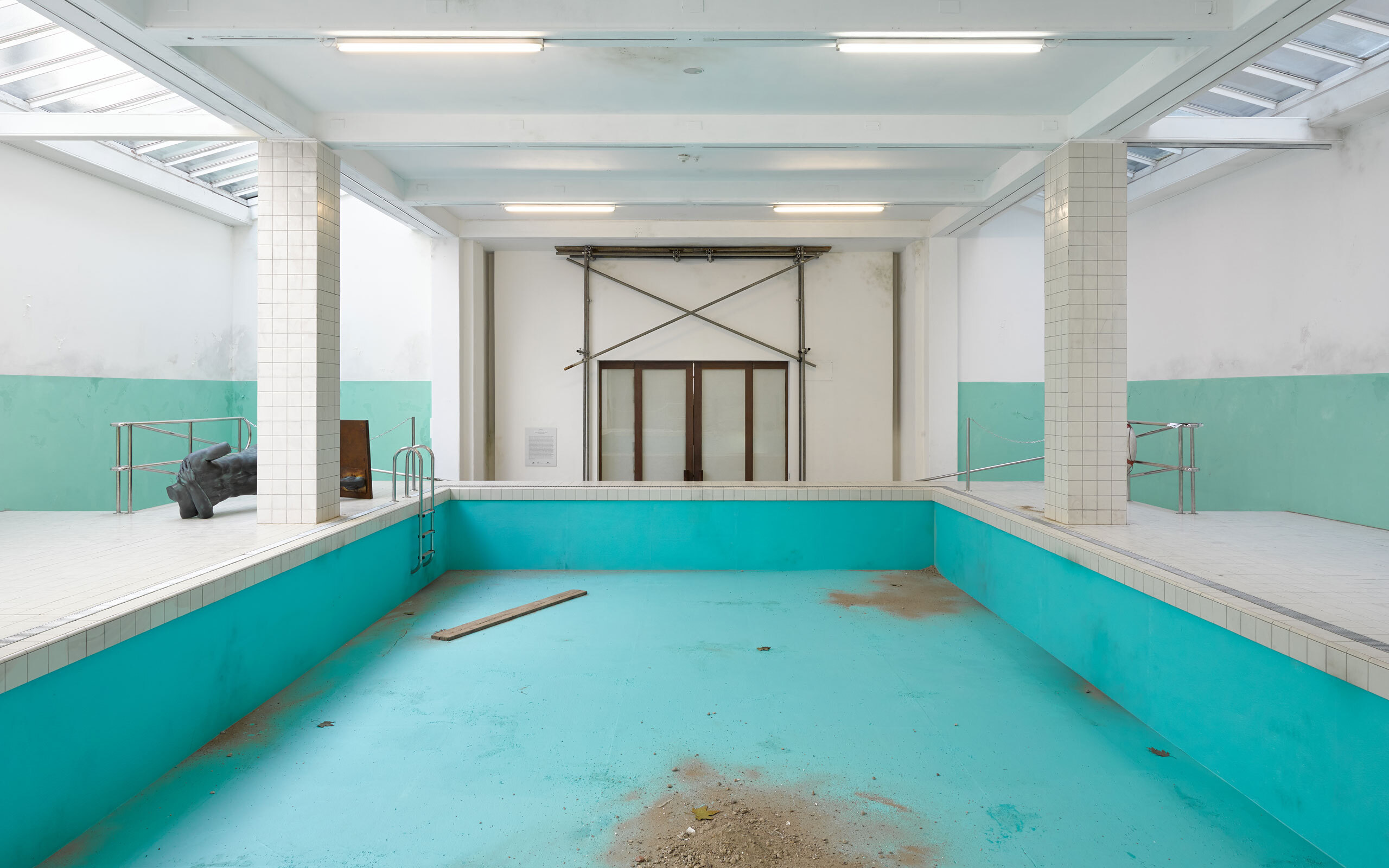The scene for contemporary art in Europe’s North is expanding and developing new dynamics as international collectors are watching the scene. With Nordic Notes we regularly cast the eye on the Nordic art and cultural scene, portraying its important actors.

From turning the Whitechapel Gallery into a swimming pool to installing a luxury apartment in the Nordic Pavilion at the Venice Biennale 2009, Elmgreen & Dragset are best known for creating immersive installations that, in their own words, “camouflage the white cube”. We visited the artists in their sprawling Berlin studio as they were preparing for a major solo exhibition, which coincides with their 25-year anniversary of working together.
Michael and Ingar, you have the reputation for having the most beautiful studio in Berlin. How did you discover this place and how long have you been working here?
Ingar Dragset: We found it 14 years ago on Immobilien Scout [a German house rental website]. The building had been sitting empty for over a decade because Neukölln was not a popular area at the time, but when we saw the building, we knew we had to have it. The fact that Neukölln changed was lucky for us. Of course, gentrification and rent increases are always a problem but it’s definitely more pleasant to live here today than it was in 2006.
What kind of a schedule do you keep?
Michael Elmgreen: We’re here basically every day. There are regular work hours, but there’s a nice atmosphere and people tend to hang out in the evenings too. This is what we wanted from the beginning because this space was so undefined, in a way. It gave us a lot of opportunities to mix things up a bit.


You have ten people working for you now. Was it difficult to go from being just the two of you to being responsible for an entire team?
ID: I think these things grow organically. At some point we just needed more help, and in many ways we’re less stressed and freaked out nowadays because we do have this group of people that can help and assist us. When there was just the two of us, we didn’t have time to do anything! There were no breaks at all. We’ve also tried bigger teams but around 10-12 people is perfect for what we do and the way we want to live. It still gives us the freedom to be creative, to sort of pull back and have our dialogue, which is, of course, very important. And then the team, as I said, has grown by necessity. Different people have different tasks and they’ve also developed their own roles. In an artist’s studio the job description is not always what you end up doing. Some of the people working here are also artists, and they come with different skill sets. We’re very flexible in that way.
Is staying flexible important to you?
ME: Well, we couldn’t imagine being 50 people because then it would be a real business. Right now, if it is a business, it’s a bit of a weird one. It’s more of a family, or a cult, or something that is somehow not professionalized. We’re very close to each other. Most of the people in the team also hang out together after hours, as Ingar mentioned. We have yoga on Thursdays, and we eat lunch together every day because it’s important to sit down and speak about other things than production. I think that as you grow it’s really important that you keep a certain level of not being professional. If you get overly professionalised, then works can tend to also be depersonalised. They can often look like they come from a factory.
One of the strengths of your practice is that while there is an Elmgreen & Dragset aesthetic your works still manage to be surprising, especially in an exhibition setting.
ME: Although we are labelled as conceptual artists, we don’t see ourselves as artists who are only working with concepts or ideas. I think there’s always something a bit wrong with what we do that makes it a bit more intimate. It addresses you in a different way than just presenting an idea.



You just closed a solo exhibition at KÖNIG in Berlin, and you have group shows coming up in Kunstmuseum Stuttgart in Germany and Shimonoseki Art Museum in Japan, as well as a solo exhibition opening at EMMA Museum of Modern Art in Finland. Do you have any hard and fast rules about how many invitations you can accept in a year?
ID: There were times when people would ask, “can you do something in three months or four months?” but that’s something we tend to say no to nowadays. When we were younger, we would say yes to everything (laughs). Now, we like to have two years to plan a show.
Your exhibition at EMMA (Espoo Museum of Modern Art) near Helsinki marks the 25th anniversary of your working together. What did you create there for this occasion.
ME: We’ve turned the museum into a carpark using very simple means, but we also added some surreal elements too. Like this sculpture [points at a lifelike sculpture of a corgi, made of artificial materials – resin and fake fur, on a children’s round- about], which is called Social Media and doesn’t fit at all! (Both laugh.)
Why a carpark?
ME: We looked at the architectural features of the museum—at the big concrete pillars and floors—and that’s what it reminded us of. The status of the car is also very different from what it was. We all feel guilty about our petrol consumption if we don’t have an electric car. It’s one of these non-spaces too. You don’t live in a car park; you don’t go to shop there; you don’t go because you like it; you park your car and then you want to get out. You also have all of these fear mechanisms at play in a car park…
ID: It’s a public space where the public don’t want to be.




How do you begin planning an exhibition like that? Do you tend to start with a site visit?
ID: Yes, we definitely start with a site visit. We’re not only looking at the physical features of the site, though, but also trying to understand what the role of the institution is. Where is it placed? Who are its users? But also, which users are absent? What is this institution lacking? I think that’s why we often come up with ideas that blend spaces such as putting a hospital into the Statens Museum for Kunst in Copenhagen or a pool in the Whitechapel Gallery in London.
ME: Certain spaces simply scream out to have their identity changed for a little while. In our early works, we did a lot of what people would call institutional critique. We made performances in which we were painting white cube galleries white for 12 hours at a time. We were testing and questioning the concept of the white cube until we realised it’s probably much better to change the environment completely, to camouflage the white cube for a certain period of time because when we do that our experience is that people look at the artworks in a different way. If the whole setting has been changed into something else, you’d look at the artwork free of admiration for the art institution. The piece can look much weirder if you turn the exhibition space into a carpark, abandoned pool, apartment, airport, or as we did once in Beijing, an art fair made up of our own works.
Do you have a favourite transformation from the last few years?
ID: That’s a hard one, but I think the exhibition at the Whitechapel Gallery was one of our highlights because it seemed to tap into the post-Brexit atmosphere in London at the time. It became part of a wider debate.


In your 2014 catalogue Biography, Marianne Torp referred to your exhibition-installations as “hyper repetitions”, which “by repeating reality… blur the differences between the ‘original real’ and their continuously repeated versions”. Do you identify with that description?
ID: We never aim to make things a hundred percent realistic. It’s not a film set. We just want to transform spaces enough for people to want to play along.
ME: It’s sort of like how you remember a dream. You might not remember all the interior features of a room, but you remember the basic elements. I think we also do this because we want the objects to perform. Sculptures in white cube spaces can sometimes be very dead and materialistic, whereas if you transform the space you’ve suddenly make a situation where the visitor feels like something has just happened or something is about to happen. The objects become part of that; they get a performative role.
ID: And the hierarchy between different objects also collapses or tends to collapse because we often use a combination of everyday objects, design objects, furniture, and high art.
Is storytelling important to you both? Do you relate to literature at all?
In our exhibition Short Story at KÖNIG, we spoke about how when you read a short story, you imagine what the characters and the scenery look like. We do the opposite. We provide the scenery, and how the characters look and from that you can make your story. So, it’s just like the reverse process of what happens when you read because most of our narratives are very open, interpret the storyline in many different ways. We’re not dictatorial about how people should perceive the show, but we try to make a platform for an experience that can create different possibilities of narratives.


Elmgreen & Dragset, Short Story, 2020, Installation views, Net, wood, aluminium, paint, EPDM rubber, 117.5 x 2,000 x 905 cm
Courtesy: König Galerie
Photo by: Roman März

Elmgreen & Dragset, Short Story, 2020, Installation views, Net, wood, aluminium, paint, EPDM rubber, 117.5 x 2,000 x 905 cm
Courtesy: König Galerie
Photo by: Roman März
You also regularly curate exhibitions too, most notably you worked together on the 15th Istanbul Biennale in 2017. When did that become a part of your practice?
ID: Well, first of all, curating is a very collaborative process and obviously we’re people who like collaborating.
ME: When we started making work together, it was at a time when the Scandinavian art scene was very DIY. It was common to start an artist-run space and curate your friends—so it wasn’t so strange for us to start putting together exhibitions. We also play a big part in curating our own shows in institutions. We have a collaboration with curators of course, but we’re not the kind of artists who send a lot of crates and then the team at the museum unpack it and the curator decides where things are placed. They would have to wait until we die to do that!
The difference, of course, is that when you were setting up artist-run-spaces with friends you were all on a similar level, whereas now as successful artists you have the opportunity, or the responsibility really, to present new voices. How did you find that experience, particularly in Istanbul, which featured many young artists?
ID: It was amazing to have a year and a half to travel the world to meet artists and to see what was going on in different regions and discover a generation of artists who we couldn’t possibly know because we’re middle aged (laughs) and you don’t meet people in the same way as you do when you’re younger.
ME: Plus, it’s a little bit creepy if we were to call a young artist and ask if we could come to see their studio to see what they do. It would sound like we either wanted to harass them or steal their ideas! (Laughs.) But when we curate, we can do it, and that was really interesting.
ID: It also gave us a chance to call up people who we had admired and been inspired by for many years. Fred Wilson, for instance, did a big project at the Istanbul Biennale.
ME: And then as an artist, it’s really nice to try to do something different from that which you found annoying in a prior biennale context before. For Istanbul, we made the decision to invite far fewer artists than is usual, which I’m very proud to see a lot of bigger art events have done since. We only had around 50 artists so everyone had enough space to create a whole universe.

In the past few years people seem to have realised that the growth of biennales, which always seem to be adding more artists, events and venues, is unsustainable. This is especially true in a landscape affected by the Covid-19 pandemic.
ME: I’m extremely curious how it develops. It was extremely beautiful during the show at KÖNIG in May because although we couldn’t have a big opening, people came in smaller numbers, and you certainly could see how much people appreciated socialising and seeing art because they had been in lockdown for so long. It that showed that if we’re not overfed, we don’t actually become fatigued.
Did anything else change for you both because of the lockdown?
ID: We had a lot of big projects on the go, so we never stopped working really.
ME: But we were working on something that was supposed to go to Art Basel, which got cancelled. I think all artists experienced on some level some changes in that way, and then you find out that the world is not collapsing because of one project. It’s a pity but you get over it.
ME: One positive thing that has come out of this situation is that people are more focused on their local scene. A place like Berlin has actually regained a bit of its status as being an interesting place to look at art, where before it was always like: oh yeah, but I’m on my way to Beijing and Hong Kong, and now it’s about actually trying to find ways to do things in the city for people who are in our region. It’s also about realising what resources are here. There are plenty of people to collaborate with.

Elmgreen & Dragset, 2020, Installation views, EMMA - Espoo Museum of Modern Art, Espoo, Finland 2020-21
Photo by: Paula Virta / EMMA

Elmgreen & Dragset, The Wait, Installation views, EMMA - Espoo Museum of Modern Art, Espoo, Finland 2020-21
Photo by: Paula Virta / EMMA

Elmgreen & Dragset, The Whitechapel Pool, 2018, Installation views, Mixed media, dimensions variable
Courtesy: *the artists, Whitechapel Gallery
Photo by: Jack Hems

Elmgreen & Dragset, The Whitechapel Pool, 2018, Installation views, Mixed media, dimensions variable
Courtesy: *the artists, Whitechapel Gallery
Photo by: Jack Hems
Interview: Chloe Stead
Photos: Katharina Poblotzki






